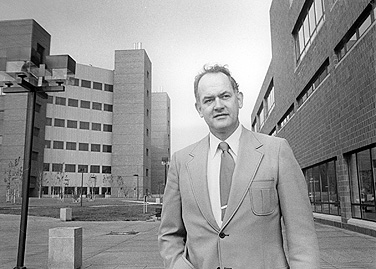Flashback
40 years ago
The Ketter years

Robert Ketter held the UB presidency during tumultuous times. Photo: UB ARCHIVES
When Robert L. Ketter was inaugurated as UB’s 11th president on Feb. 15, 1971, he was no stranger to UB.
Born in West Virginia in 1928, Ketter received his doctorate in civil engineering from Lehigh University and taught there before coming to UB in 1958 as the first chair of the new Department of Civil Engineering. He went on to serve as dean of the Graduate School before being named UB’s first vice president for facilities planning in 1967, a year before the groundbreaking for UB’s new campus in Amherst.
As vice president for facilities planning, Ketter was charged with overseeing the development of a new central campus to accommodate an anticipated 40,000 students. The state’s concerns about the projected cost of the project and labor issues related to opportunities for minority employment delayed work for two years. Frustrated by the delays, Ketter left his administrative post to return to teaching.
In the spring of 1970, national social turmoil and anti-war sentiment were being felt at UB, with periods of campus unrest that included violence. Seeking Ketter’s assistance in dealing with student protests, acting UB president Peter F. Regan made Ketter head of the new Temporary Hearing Commission on Campus Disruption.
It also was during that spring that UB was looking for a new president to replace Martin Meyerson, who had left UB to assume the presidency of the University of Pennsylvania. The university had been occupied by the Buffalo police, its merger with SUNY was still a recent event, and university-community relations were strained because of the social turmoil on campus and controversies surrounding where to locate UB’s new campus.
The UB Council, charged with recommending a new president, selected Ketter: someone known to the university and the larger community, the person most familiar with the university’s building plan and, not insignificantly, the “law and order” candidate—a label given to Ketter as result of his leadership of the Temporary Hearing Commission on Campus Disruption, a group that did not hesitate to issue expulsions and suspensions.
As the new president, Ketter considered the most urgent problem facing the university to be “trying to bring back the oneness of the university community.” He vowed to be a visible president on campus and also in the community, where he spoke to 120 groups during his first year as president.
Ketter’s reputation for “law and order” followed him into his presidency and he periodically faced resistance from both student and faculty groups. He resigned in 1982 to return to teaching and research.
In 1986, he succeeded in securing a $25 million grant from the National Science Foundation to establish the National Center for Earthquake Engineering Research (NCEER), predecessor of the current MCEER—Multidisciplinary Center for Earthquake Engineering Research. Before Ketter’s death in 1989, the center had developed a research program involving more than 80 scholars worldwide and established cooperative agreements in Mexico, Japan, China and Taiwan.
After Ketter’s death, UB President Steven Sample described what he referred to as the “Ketter years”: “a period of remarkable evolution from a good university to a major institution enjoying national and international acclaim. It was a time when the seeds were planted that yield up the fruits of many of our most significant accomplishments: the encouragement of the university’s international relations and its contact with foreign universities, the establishment of a university honors program, expanded funding for research and for centers of excellence, the attainment of a renewed respect for our university in the Western New York community, the creation of new avenues for support from the private sector, the development of responsive minority programs and, perhaps most dramatic of all, the completion of a new campus that represents the largest single academic building project in the country’s history.”
The University Archives hold the papers of Robert L. Ketter and several other collections related to his tenure as president, along with exhaustive textual and visual documentation on the planning and development of the North Campus. Records of NCEER and MCEER also are available in the archives.
—John Edens, University Archives

Reader Comments